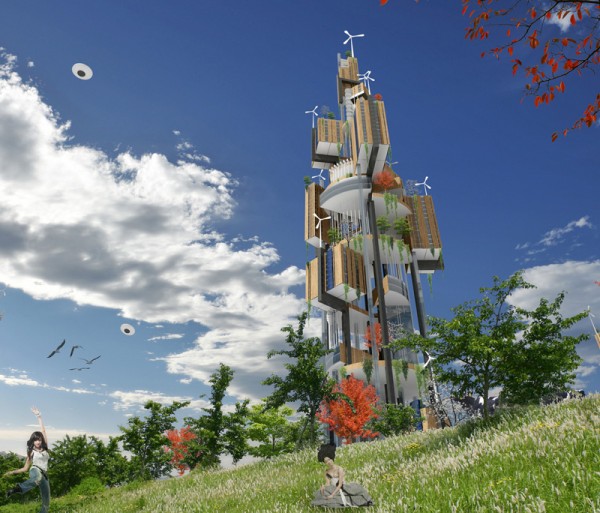Italo Calvino’s invisible city of Zenobia was one of the most suggestive surreal images of the late 1900's. Now, the invisible has became 'the possible'. It is a real-life project , even (perhaps) a practical proposal. If ever built, Zenobia (below) will be a 'decipherment', and a city like no other.
Now I shall tell of the city of Zenobia, which is wonderful in this fashion: though set on dry terrain it stands in high pilings, and the houses are of bamboo and zinc, with many platforms and balconies placed on stilts at various heights, crossing one another, linked by ladders and hanging sidewalks, surmounted by cone-roofed belvederes, barrels storing water, weather vanes, jutting pulleys, and fish poles, and cranes.
No one remembers what need or command or desire drove Zenobia’s founders to give their city this form, and so there is no telling whether it was satisfied by the city as we see it today, which has perhaps grown through successive superimpositions from the first, now undecipherable plan. But what is certain is that if you ask an inhabitant of Zenobia to describe his vision of a happy life, it is always a city like Zenobia that he imagines, with its pilings and its suspended stairways, a Zenobia perhaps quite different, a-flutter with banners and ribbons, but always derived by combining elements of that first model.
This said, it is pointless trying to decide whether Zenobia is to be classified among happy cities or among the unhappy. It makes no sense to divide cities into these two species, but rather into another two: those that through the years and the changes continue to give their form to desires, and those in which desires either erase the city or are erased by it.
(From Le Città Invisibili by Italo Calvino; translation William Weaver)
Designed by Italian architects Alessandro Tonni and Manuela Spera, the city Calvino inspired is meant to create a meeting point between architecture and literature. Calvino, I think, would have relished it.
Invisible Cities
In a garden sit the aged Kublai Khan and the young Marco Polo -- Tartar emperor and Venetian traveller. The mood is sunset. Kublai Khan has sensed the end of his empire, of his cities, of himself.
Marco Polo diverts the emperor with tales of cities that he has seen within the empire and Kublai Khan listens, searches for a pattern in Marco Polo's cities. Here are all the cities ever dreamed of, strange magical invisible cities that nobody else ever saw. All are named after women (as they must be, since cities are feminine in Italian) -- Raissa, Irene, Phyillis, Olinda, Armilla, Chloe, Valdrada...
The ancients built Valdrada on the shores of a lake, with houses all verandas one above the other, and high streets whose railed parapets look out over the water. Thus the traveler, arriving, sees two cities: one erect above the lake, and the other reflected, upside down. Nothing exists or happens in the one Valdrada that the other Valdrada does not repeat, because the city was so constructed that its every point would be reflected in its mirror, and the Valdrada down in the water contains not only all the flutings and juttings of the facades that rise above the lake, but also the rooms' interiors with ceilings and floors, the perspective of the halls, the mirrors of the wardrobes.And Zobeide...
From there, after six days and seven nights, you arrive at Zobeide, the white city, well exposed to the moon, with streets wound about themselves as in a skein. They tell this tale of its foundation: men of various nations had an identical dream. They saw a woman running at night through an unknown city; she was seen from behind, with long hair, and she was naked. They dreamed of pursuing her. As they twisted and turned, each of them lost her. After the dream they set out in search of that city; they never found it, but they found one another; they decided to build a city like the one in the dream. In laying out the streets, each followed the course of his pursuit; at the spot where they had lost the fugitive's trail, they arranged spaces and walls differently from the dream, so she would be unable to escape again.The emperor soon determines that each of these fantastic places is really the same place.
Marco Polo agrees: "Memory's images, once they are fixed in words, are erased...."
But the traveller still cannot stop.
- he must go on to another city, where another of his pasts awaits him, or something perhaps that had been a possible future of his and is now someone else's present. Futures not achieved are only branches of the past: dead branches.The dialogue continues (Cities & Memory, Cities & Desire, Cities & Signs) yet, as Calvino tells us, "most of the time they remained silent and immobile."
"Journeys to relive your past?" was Kublai Khan's question at this point, a question which could also have been formulated: "Journeys to recover your future?"
And Marco's answer was: "Elsewhere is a negative mirror. The traveller recognizes the little that is his, discovering the much he has not had and will never have."
Finally, Kublai Khan recognizes that all cities are tending toward the concentric circles of Dante's hell.
Of course Zenobia will never be built.He said: "It is all useless, if the last landing place can only be the infernal city, and it is there that, in ever-narrowing circles, the current is drawing us."
And Polo said: "The inferno of the living is not something that will be; if there is one, it is what is already here, the inferno where we live every day, that we form by being together. There are two ways to escape suffering it. The first is easy for many: accept the inferno and become such a part of it that you can no longer see it. The second is risky and demands constant vigilance and apprehension; seek and learn to recognize who and what, in the midst of the inferno, are not inferno, then make them endure, give them space."
Which would suit Calvino perfectly. As he said of himself, "The ideal place for me is the one in which it is most natural to live as a foreigner."
I've made much use of the brilliant review of Calvino's Novels by Gore Vidal (New York Review of Books)
Major Calvino websites at: Emory University, Swarthmore College and Outside the Town of Malbork
Illustrations from 'Reinterpreting Italo Calvino's Zenobia' at Evolo us News 31 July 2010. The architects may be found at Architizer.


No comments:
Post a Comment